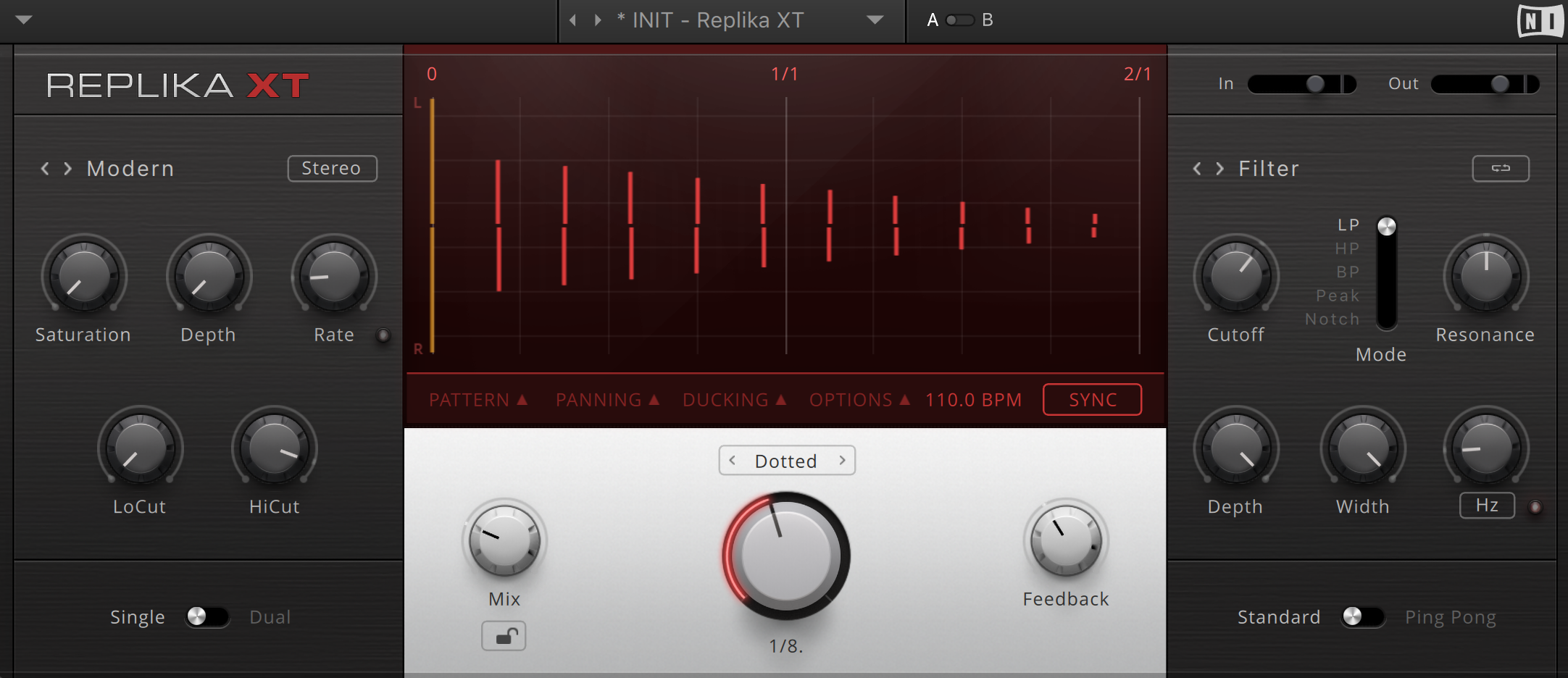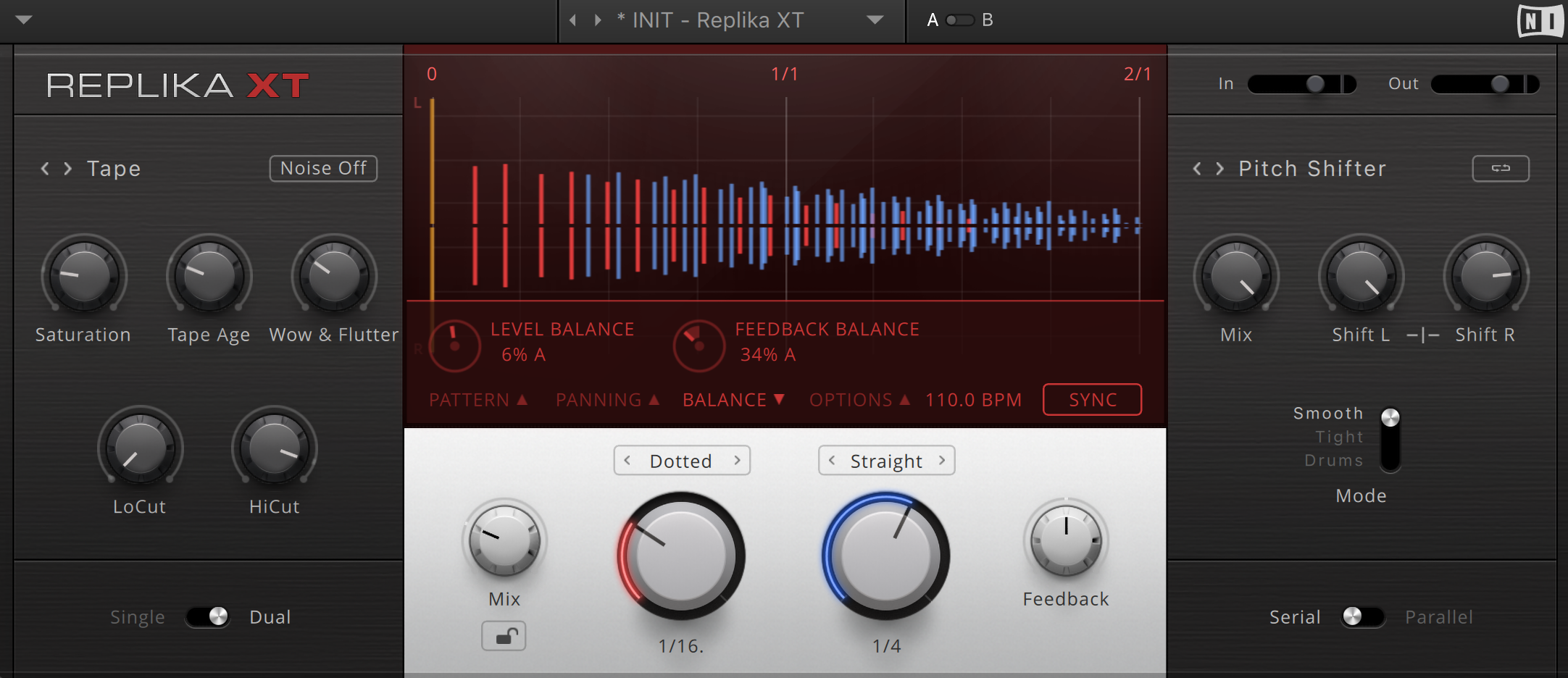REPLIKA XT Review
Native Instruments’ Replika XT is likely a delay you haven’t given much thought. An expanded version of the likely more popular Replika, XT adds several neat features making it worthwhile to play with. I think its lack of popularity is owed mostly to Replika being available in komplete, but XT available in Komplete Ultimate, narrowing the potential user base significantly. I likely wont do a review of standard Replika, so I’ll say a few things about it here, for one, it is a very easy delay to use, I think they did a great job of balancing the mix curve, giving you easy control over the delay volume, without going too loud too fast. It has always been my go to stereo/ping pong dotted delay, I kinda just use Replika as a preset and opt for more advanced delays when I want more options.
Replika XT offers 5 different delay algorithms and 7 different effects, some of which can be placed into the feedback loop. Additionally there are controls for pattern, panning, and ducking which allow for different control over the echoes. The pattern panel can shuffle every other echo, accent every other, and shift the feel forwards or back. There is also a dual delay mode which gives you 2 separate delays, each with their own delay time and pattern controls, these can be run in series or parallel.
The UI is quite beautiful, especially for a skeuomorphic design, which can often times be off putting. The center display in red is pleasing to look at while being informative, and the layout and menus are all easily accessible and intuitive. playing with pattern settings and delay time, especially in dual delay/series mode can be quite mesmerizing as graphics update to show you the echo patterns.
Modern: This one is a clean delay, best used when you just want a transparent echo. there is some filtering and a saturation control if you want to add some subtle dirt in. This is the only algorithm with instant delay time changes that don’t pitch when adjusted, nice for creating granular effects when modulated externally.
Analogue: A dirtier circuit based algorithm, has 4 different modes based on a bucket brigade for various styles of classic delays. Old analog BBD circuits would use capacitors to store voltages which would be read out later based on clock cycles, they are not exactly analog as they rely on reading out values based on discrete timings, and not technically digital either as those values are stored by capacitance instead of a discrete binary number.
Tape: Designed to replicate tape delays it includes a tape age control that provides some pleasant break up, and wow/flutter for that warbling tape sound. Wow & flutter are based on delay time, so a short delay will warble faster than a slow one. To my ears the saturation control sounds the same as in the modern mode, it’d have been nice if each had a unique distortion
Vintage Digital: Is based on older digital delays, you get a quality control to choose from 4 different levels of clarity. These are much more noticeable after several repeated echoes, besides the crunch mode, which has very noticeable sample rate reduction.
Diffusion: Unlike some other creative delays, Replika XT has uses a whole mode for diffusion, so unfortunately you can’t combine other algorithms with diffusion. NI has made up for this by creating an exceptional quality diffusion algorithm. The amount size and movement controls all shape the spread and blur of this algorithm, which is capable of incredibly lush tones. You can easily create amazing sustained reverbs with this mode, or turn the amount down lower to create a delay that slowly morphs with each echo into a reverberated version of its self.
EFFECTS: The 7 effects in Replika XT really add a lot to the experience, there’s the typical modulation effects for adding chorus or phasing to the delayed signal, then there’s a frequency shifter, filter, and pitch shifter that can be added into the feedback loop. I really love the frequency shifter, putting it in the loop can make for some insane tones, where each echo becomes progressively thrown out of harmony, it can be slow for phasing sounds, or up to 1 khz for ringing madness. Speaking of which, it has a ring mod option alongside all the various shifting choices. The Pitch shifter is also fun in the feedback loop, it’s not the best algorithm, so it gets unstable after a couple octaves, but this is perfectly fine for shimmers. The filter is a bit redundant as there’s already filtering in all of the delay modes, but having resonance can be nice, there’s also a notch option. As for the micro pitcher, I’ve yet to be able to figure out exactly what this does, it seems to add just the most subtle motion to the delay time to make things more natural sounding.
Combining these various delay modes with the effects, and the ability for both dual delay and pattern adjustments makes Replika XT an extensive creative delay. It really helps that each algorithm sounds great and the included effects are high quality as well. The delay time control can go all the way down to 0 with a resolution of 1 ms making for some great resonators and short delay sounds. Having the frequency shifter is a big reason I’ll reach for this one in the future. It’s a shame there’s no internal modulation besides the predefined lfo for delay time in some algorithms, as adjusting delay time, diffusion size and various other controls in Replika XT result in some amazing sounds. They are capable of being modulated externally, it would just always be nice to craft this into a preset rather than relying on a daw specific setup.
If you plan on purchasing MORPH EQ from Plugin Boutique, please consider supporting me by using my affiliate link
REPLIKA XT: https://www.pluginboutique.com/product/2-Effects/10-Delay/10999-Replika-XT?a_aid=61c378ab215d5




